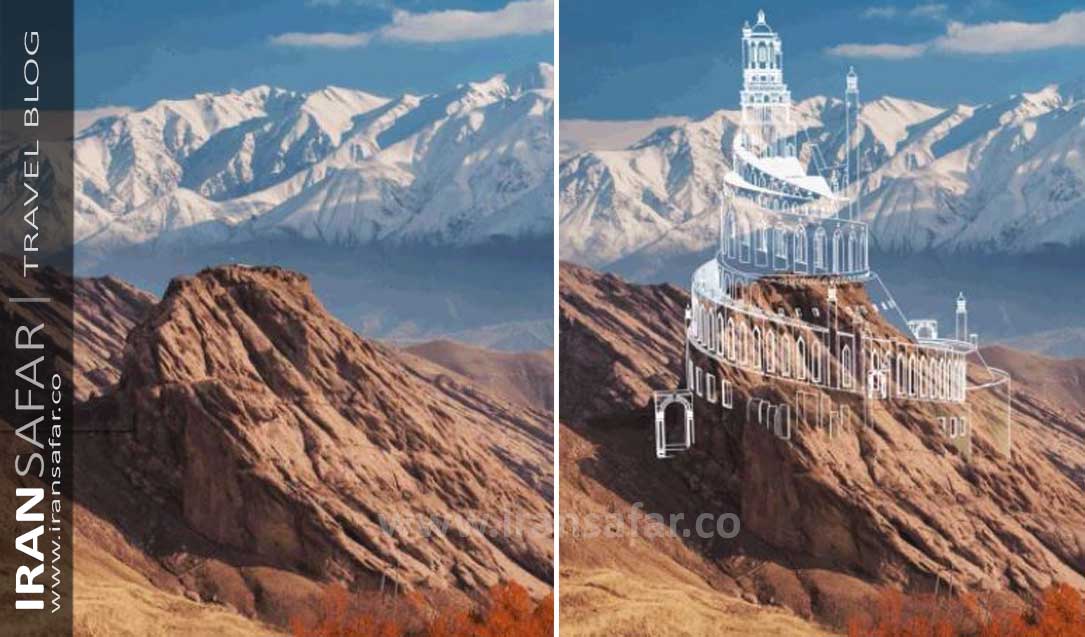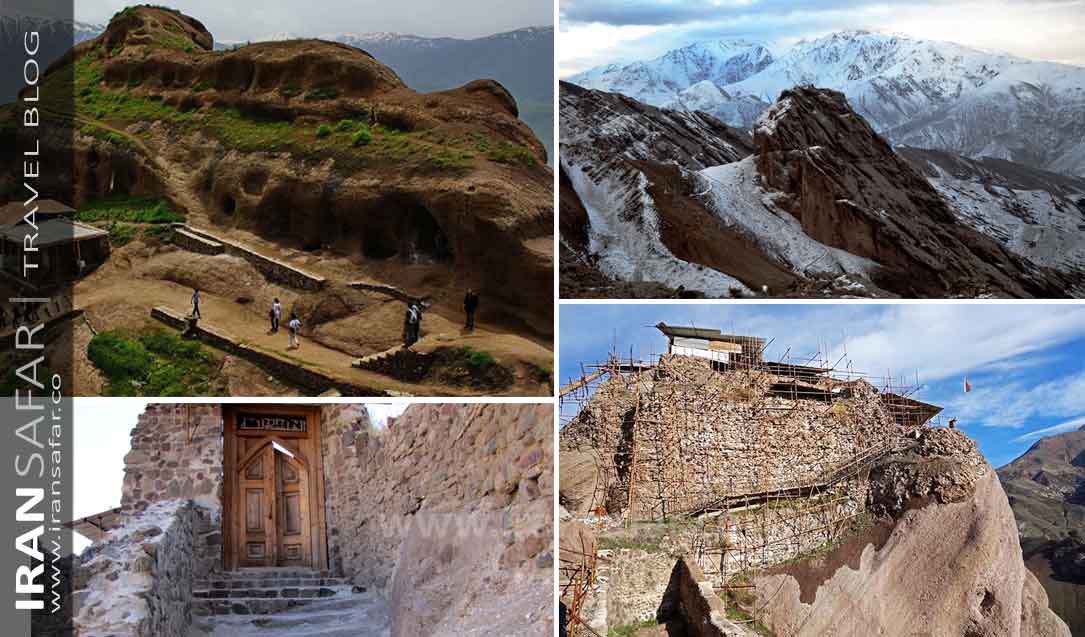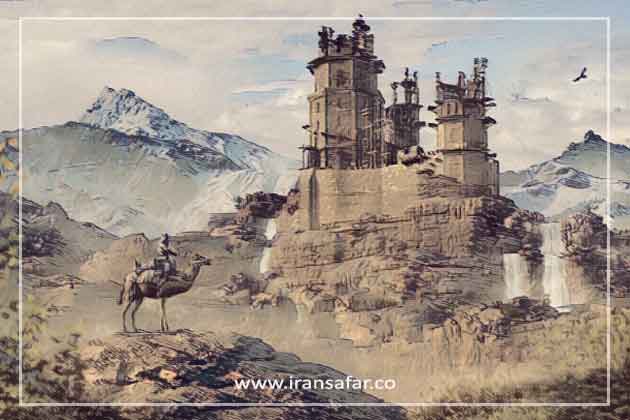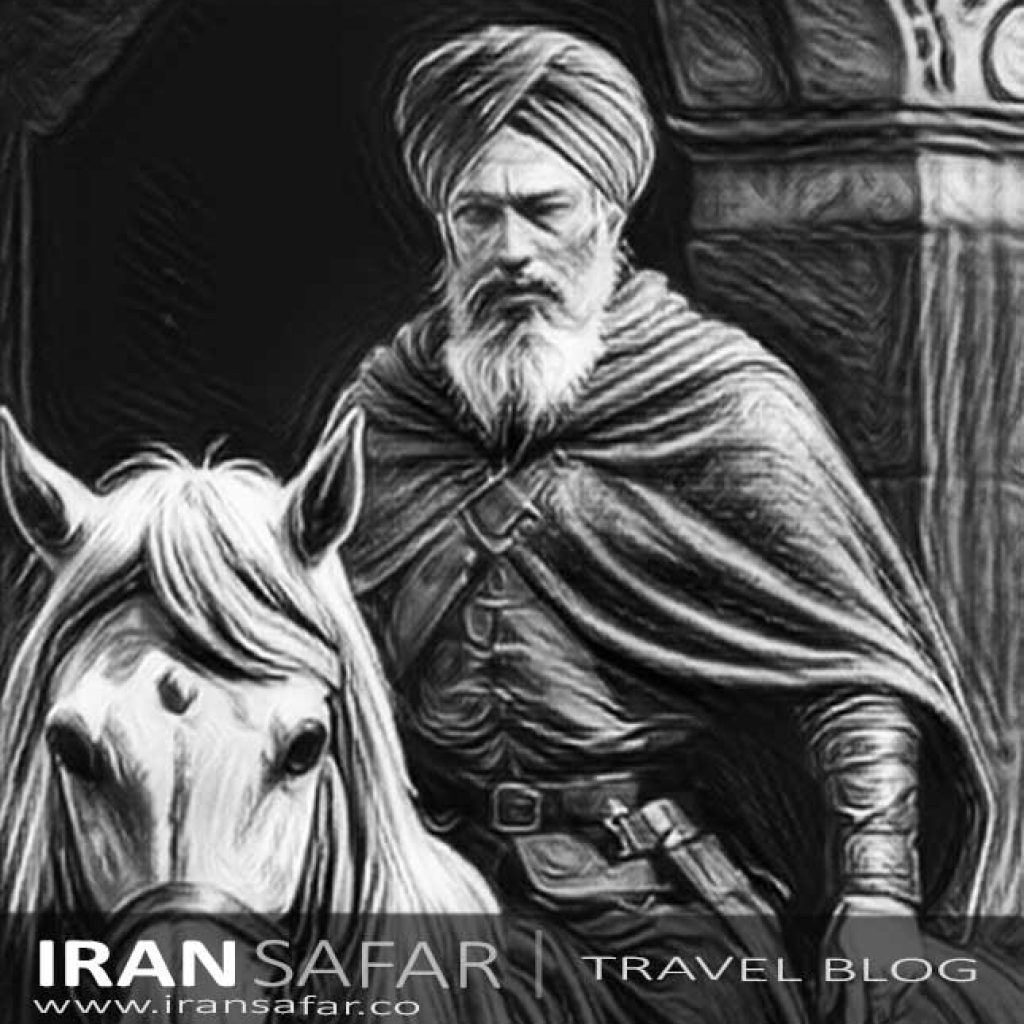One of the most important sights in Qazvin province is Alamut Castle, whose name is on the list of the most famous castles of Iran. This castle, in addition to being a unique historical attraction, also has a very beautiful and soulful nature. Alamut has spent its most important historical period in the 11th century AD and during the rule of Hassan Sabah over this region. Hassan Sabah used this castle as a military headquarters. There are many stories about Alamut Castle in this historical period. Whether you are among those who are interested in history, ancient monuments or Iran’s natural attractions, you’d love Alamut Castle and surrounding area.

History of the Alamut Castle
The history of Alamut Castle is also interwoven with legends and myths that have persisted through the ages. According to historical books, Hassan Sabah went to Egypt after being expelled from the Seljuk king’s court and learned the principles of Ismaili. After returning to Iran, he checked many places to carry out his activities and finally reached Alamut, Qazvin. Finding Alamut and its unattainable castle, he rebelled against the ruler of this region and defeated him.
When Hassan Sabah captured Alamut Castle, he paid an amount equal to 3000 gold dinars for the castle to the defeated ruler. The fortress was strategically positioned, perched on a rocky outcrop within the Alborz mountain range, making it virtually impregnable. It soon became a place for the political-military activities of Hassan Sabah and his disciples. Historians consider this incident to be related to the year 1093 AD.
Throughout history, many activities and events have caused the destruction of this historical and fortified building. The castle’s fortunes took a turn during the Mongol invasion in the 13th century. In 1260s, conquered Alamut and burned its library. Despite its resilient defenses, Alamut Castle eventually fell to the Mongol forces. This caused a part of this castle to be destroyed and then turned into a place of exile.
At the same time, the followers of the Ismaili sect, who were still engaged in political and military activities, conquered the fort again; Of course, this occupation lasted for a short time. During the Safavid Empire era, changes were made in the castle and constructions were made in some parts to create a secure government prison.
During the Qajar era, due to the negligence of the government, important parts of this castle were destroyed. Some people have always considered Alamut Castle as a treasure shelter and illegal excavations led to destroy some remaining. Over time, the fortress was abandoned and left to nature’s mercy. However, Alamut Castle’s legacy was not forgotten, and in recent years, it has been rediscovered as a historical and archaeological site of immense significance.
Alamut & Hassan Sabah
Many stories and legends about the secrets of Alamut Castle have been passed down to the present generation. What is closest to reality and mentioned in some historical books is the story of “Three school friends”.
The name of Hassan Sabah and Alamut Castle are so intertwined with strange stories. The term “Three school friend” that we have all heard these days is actually derived from the story by Edward Fitzgerald (1809 – 1883), an English writer and poet
In 1859, he translated Khayyam’s quatrains into English and wrote at the beginning of the book: “Khwaja Nizam al-Mulk, Khayyam Neishaburi and Hassan Sabah were three school friends. They made a pact with each other that whenever one of them reached a position of power, he would help the other two. The apple of the covenant tree of these three people, when it fell on the ground, turned in such a way that Khwaja Nizam al-Mulk became the minister of the Seljuk court. He provided conditions for Khayyam to write and do his scientific work with ease. He made Hassan Sabah a position in the court; But soon a difference of opinion arose between these two friends and Malik Shah rejected Sabah from the court. This is how Sabah went to Africa and created a sect that became known as Hashashin or often referred to as Assassins.
Who was Hassan Sabah?
Hassan Sabah (1050 – 1124) was one of those who revolted during the Seljuk period. The religion of him and his followers was Nizari Ismailism (also known as Seveners – see religions of Iran), which is a branch of the Shi’a. The center of their power was in Egypt, where the Fatimid caliphs of Egypt declared this religion official in this country.
Hassan Sabah is a very mysterious and strange figure in the history of Iran and Islam. He created a sect that can be called the world’s first terrorist organization. Many of the tricks of brainwashing and terror and cult of personality that are used today by fundamentalist groups such as the ISIS and the Taliban have their roots in Hassan Sabah’s methods.
He believed that his way was the way of truth, and the life and property of no human being is as valuable as the truth. For this reason, killing people in the direction of beliefs and in the name of religion was easy for him and his followers. The devotees of Hassan Sabah were ready to do the most brutal acts possible and take their lives and others with the hint of their leader.
How Alamut was seized?
While Hassan Sabah was learning the principles of Ismaili faith in Egypt, the Seljuk government was growing and progressing with the help of the wise Iranian minister Nizam al-Molk. King Malik Shah was the third Seljuk monarch who had a friendly relationship with the Abbasid Caliphate. The common concern of the Abbasids and the Seljuks was the rebellions created in Syria, which had reached Egypt, the center of the Fatimid Caliphate. After returning from Egypt, Hassan traveled for 9 years as an inviter of the Ismaili faith in Iran and planned his revolutionary policies and also examined the military power of the Seljuks in different regions.
Until around 1087, Sabah had focused its attention on the shores of the Caspian Sea, especially the mountainous region of Deylam. Since ancient times, this region was a refuge for minorities such as Alawites and Shiites, and it was far away from the power centers of the Seljuks in the center and west of Iran. At the same time, Sabah was looking for a suitable place for his anti-Seljuk rebellion, where he could establish his base of operations.
At the end of the year 1090 AD, he chose Alamut Castle in Rudbar region. At that time, Alamut was in the hands of a ruler named Mahdi Alavi. Hasan sent some of his skilled preachers to that area to invite the people to the Ismaili faith and also called the Ismailis from different areas and settled them in the same area. He secretly entered the castle on the night of September 4, 1090 AD in disguise of a teacher and started to teach the children of the castle guards. In this way, many guards joined the Ismaili religion. The followers of Sabah increased inside and outside Alamut Castle and the owner of the castle soon found out that he had no choice but to hand over the castle to Hassan Sabah. The Assassins easily captured the fort in the late autumn of 1090. Sabah ordered to pay 3000 dinars as compensation and became the legal owner of the castle. The capture of this fort was the beginning of the armed uprising of the Ismailis of Iran against the Seljuks and also marked the establishment of the independent state of the Ismailis of Alamut.
Hassan Sabah against Seljuks
The Alamut Fort brought the activities of the Ismailis of Iran, who had been operating secretly until then, into a new phase. In fact, this was the beginning of the armed uprising of the Ismailis against the Seljuks, and at the same time, it marked the actual establishment of what was destined to become the independent state of the Nizari Ismailis. It is certain that Cairo did not play a role in the beginning of this phase of the revolutionary activities. On the contrary, the available evidence indicates that until that date, Hassan Sabah did not have close relations with the Fatimid government of Egypt.
Hassan Sabah had a set of religious and political motivations for the uprising against the Seljuks. Obviously, as an Ismaili Shi’a, he could not tolerate the anti-Shi’a policies of the Seljuks, who, as the new supporters of Sunni Islam, had sworn to overthrow the Ismaili government of the Egyptian Fatimids. A less visible, but equally important motivation in Hassan’s uprising was the expression of Iranian “national” sentiments, and this justifies the widespread initial success of this uprising in Iran. The Seljuk Turks were aliens in Iran, and their rule was strongly hated by Iranians of all classes and social groups. The riots and depredations that the Seljuks and their rebellious Turkish troops had launched in the city and countryside increased the intensity of the anti-Seljuk sentiments of Iranians more and more.
The Assassin group was widely known as a cult of assassins that killed Seljuk politicians and religious enemies, as well as financial rivals – often in broad daylight. According to some sources, the order also accepted assassination-for-hire contracts from individuals and organizations outside their own. There is even an unsubstantiated claim alleging that Richard the Lionheart hired the assassin who killed Conrad of Montferrat in 1192 CE.
Hassan Sabah was able to maintain and expand Ismailism by terrorizing and intimidating opponents. In the last years of his life, he never left Alamut Castle and always lived an ascetic life. Hassan Sabah had a large library in Alamut and knew Latin and Greek to some extent. He spent most of his time studying and worshiping, and his informants brought him the news of holy assassinations after praying.
Hassan Sabah died in the year 1124 in Alamut Castle. He was about 75 years old at the time of his death and before his death he appointed his successor and killed his male children so that they would not claim succession.
Alamut Castle’s Location & Layout
Although not much remains of this magnificent castle, there is undoubtedly much to learn and wonder about. Alamut should be visited for many reasons, one of which is its important place in history. During the medieval period, Alamut Castle played a pivotal role in the political and military landscape of the region. It served as the headquarters for the Nizari Ismailis, led by charismatic leaders who used the castle as a base to exert influence over neighboring territories.
Alamut Castle is located on an impassable rock at an altitude of 2163 meters above sea level and 200 meters from the surrounding lands. There are cliffs and steep slopes on the four sides of the fort, which made it difficult for the enemy to reach. A large part of the towers and fortifications of Alamut were destroyed and only 3 towers, in the north, south and east, remained. The eastern tower is better preserved than the others. Entering the castle is only possible from an entrance at the end of the northeast side and a few meters below the eastern tower.

Alamut Castle has two lower and upper forts. In the construction of the walls, the shape and position of the mountain rocks should have been taken into account. For this reason, the width of the castle differs in different parts. The length of this castle reaches about 120 meters and its width is between 10 and 35 meters in different places. The shape of the castle resembles a sleeping camel.The castle looks like a sleeping camel from a distance and is made of stone, brick, plaster mortar, tiles, clay tiles and wooden coils. This castle actually had four towers, the western tower of which has been destroyed over the years.
A little below the eastern tower, the entrance to the castle is located. Near the entrance, a six-meter long tunnel has been dug in the rocks. On the other side of the tunnel, there is the south tower and the southwest wall. In the southern part, a room was created in the rock, which was used as a guard house. In the northwest part, two rooms have been built, in one of which there is a small water well. The east of the castle was the residence of the guards and their families. In this part, there are animal mangers, small reservoirs and some rooms, which are unfortunately very dilapidated. Between the eastern and western parts of the castle, there is a square that is divided into two parts by the wall around it.
The castle reaches the precipice from four sides and has only one entrance, which is lower than the eastern tower; an expression of its defensive structure. Digging a moat around the castle and the presence of a watch tower made it possible to protect it. On the southern slope of the rock, there is a moat with a length of fifty meters and a width of two meters, which was dug in the past to prevent penetration into the castle. At that time, this moat was always full of water.
The stone stairs built from the bottom of the rock to the castle date back to the Qajar era. Before the construction of these stairs, mule was used to go to and from the castle. There is also a pond inside the castle, which is filled with water when it rains and gives an interesting effect to the inside of the castle.
There is a vine tree in the southwest of the castle, which is said to have been planted by Sabah himself. In the west of the castle, the very old cemetery can be seen. The brick kilns located on the hill next to the castle are also interesting because of their age and style.




I truly admire your knowledge and insights on this castle. The whole history behind it and the whole importance of it, and what once was a true majestic, impregnable fortress, that symbolised the soul of Hassan Sabah. I came onto this after seeing this in Assassin’s Creed Mirage as the castle in construction.
Would definitely want to visit this someday.
Cheers!
Wrote: Salim Bharwani
Very interesting piece of history and it needs to be preserved for the future generations – sometimes we don’t know the real facts as story gets distorted over time. As a Nizari Ismaili, I am proud that this piece of history needs to be visited in person.